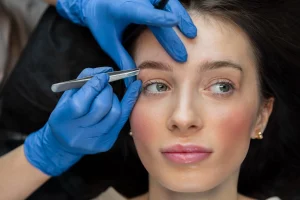In the realm of microblading, a profound grasp of facial anatomy is crucial for businesswomen looking to craft bespoke brow designs that enhance their clients’ natural beauty and confidence. Mastering facial anatomy is the cornerstone of exceptional microblading, empowering professionals to create personalized solutions that harmonize with each individual’s distinct facial structure. But what are the essential components of facial anatomy that businesswomen need to understand to achieve exceptional outcomes? The key lies in the intricate details of facial proportions, bone structure, muscle anatomy, skin layers, and symmetry – all waiting to be discovered. A comprehensive guide to facial anatomy in microblading is indispensable for businesswomen seeking to elevate their skills and deliver impeccable results to their clients.
Key Takeaways
- Accurate facial proportion analysis empowers microblading artists to craft bespoke brow designs that harmonize with unique facial structures.
- Understanding craniofacial bone structure, including the frontal, zygomatic, and maxilla bones, provides the foundation for harmonious brow designs.
- Recognizing facial muscle anatomy allows artists to design brows that complement natural muscle movements, resulting in a more natural appearance.
- Knowledge of skin layers and tissue, including the epidermis, dermis, and hypodermis, impacts the microblading procedure’s outcome and client satisfaction.
- Mastery of facial symmetry, including facial proportions, facial thirds, and the golden ratio, enables artists to achieve balanced and aesthetically pleasing results.
Understanding Facial Proportions Matters
Accurate facial proportion analysis is a vital aspect of a thorough In-depth guide to facial anatomy in microblading, as it empowers microblading artists to create bespoke brow designs that harmonize with each client’s unique facial structure. By recognizing the detailed relationships between facial features, artists can craft tailored solutions that boost clients’ natural beauty and confidence.
Delving Into Bone Structure Fundamentals
The craniofacial bone structure, comprising 22 bones that form the skull, serves as the foundation of facial anatomy, providing a framework for microblading artists to create harmonious and balanced brow designs.
Key components of the craniofacial bone structure include:
- Frontal bone: forms the forehead and roof of the orbit
2. Zygomatic bone: forms the cheekbone and orbit - Maxilla bone: forms the upper jawbone and orbit
4. Mandible bone: forms the lower jawbone
Mastering Facial Muscle Anatomy Essentials
Beyond the craniofacial bone structure, a thorough understanding of facial muscle anatomy is crucial for microblading artists to create bespoke brow designs that complement their clients’ unique facial features. In a detailed guide to facial anatomy in microblading, understanding facial muscles empowers artists to design brows that harmonize with the client’s natural muscle movements, resulting in a more natural and aesthetically pleasing appearance.
Navigating Skin Layers and Subcutaneous Tissue
Three primary skin layers, including the epidermis, dermis, and hypodermis, play an important role in microblading, as they directly impact the procedure’s outcome and the client’s overall satisfaction. Grasping these layers is vital for a thorough guide to facial anatomy in microblading.
- Epidermis: The outermost layer, responsible for skin pigmentation and protection.
- Dermis: The middle layer, comprising blood vessels, nerve endings, and hair follicles.
- Hypodermis: The innermost layer, consisting of subcutaneous fat, connective tissue, and fascia.
- Subcutaneous tissue: The layer of fat and connective tissue beneath the dermis.

Unlocking the Secrets of Facial Symmetry
Understanding the skin layers and subcutaneous tissue is a fundamental aspect of microblading, and a thorough comprehension of facial anatomy requires a deep understanding of facial symmetry, which plays a vital role in achieving balanced and aesthetically pleasing results. A detailed guide to facial anatomy in microblading must encompass the study of facial proportions, facial thirds, and the golden ratio to create harmony and balance in microblading designs.
Frequently Asked Questions
Can Microblading Damage Facial Nerves or Cause Numbness?
Microblading, when performed correctly, poses minimal risk to facial nerves and numbness; nevertheless, improper technique or inexperienced practitioners may cause damage, underscoring the significance of selecting a qualified professional to guarantee safe and effective results.
How Do I Handle Clients With Asymmetrical Facial Features?
When dealing with clients with asymmetrical facial features, it’s crucial to evaluate their unique anatomy and adjust microblading techniques accordingly, guaranteeing personalized results that harmonize their facial structure and elevate their natural beauty.
Are There Any Specific Facial Anatomy Considerations for Older Clients?
When working with older clients, consider age-related facial anatomy changes, such as skin laxity, facial sagging, and bone resorption, to guarantee tailored microblading techniques that address these unique considerations and yield best results.
Can I Use Facial Anatomy Knowledge to Improve My Microblading Designs?
Indeed, comprehending facial anatomy empowers microblading artists to craft tailored designs that complement clients’ unique facial structures, guaranteeing harmonious and balanced outcomes that elevate their natural beauty.’
Do I Need to Study Facial Anatomy for Each Individual Client or Is There a General Approach?
While a general understanding of facial anatomy is important, it’s vital to study each client’s unique facial structure to tailor microblading designs that complement their individual features and achieve best results.
Conclusion
Facial anatomy mastery is vital for businesswomen in microblading, as it empowers them to craft bespoke brow designs that elevate clients’ natural beauty and confidence. By understanding facial proportions, bone structure fundamentals, facial muscle anatomy, skin layers, and facial symmetry, microblading professionals can create tailored solutions that harmonize with each individual’s unique facial structure, resulting in aesthetically pleasing and balanced results. This in-depth understanding is necessary for delivering exceptional microblading services that exceed client expectations.
You May Also Like:





